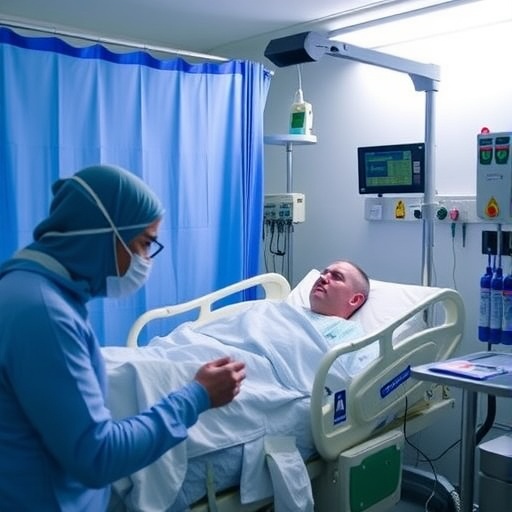
Credit: Georgia State University
ATLANTA–Arteriviruses, a family of single-stranded RNA viruses that belongs to the order Nidovirales, produce more proteins and messenger RNAs than previously reported, a finding that provides important insights about a virus that could potentially evolve to infect humans in the future, according to a new research study.
Previously, only nine genome sequences, known as transcription regulatory sequences (TRSs), were reported for the arterivirus Simian hemorrhagic fever virus (SHFV), which infects monkeys. However, the new study used next-generation sequencing technology and found 96 TRSs were used by this virus to produce subgenomic messenger RNAs (sg mRNAs) in both SHFV-infected kidney cells and white blood cells of macaques, monkeys found primarily in Asia. Four of the previously identified TRSs were found not to be the predominant ones used for gene expression.
The findings are published in the journal Proceedings of the National Academy of Sciences.
"This virus currently doesn't infect chimpanzees or humans, but it's one of the viruses that's recently been put on a list of possible emerging viruses that could evolve to infect chimpanzees and/or humans in the future," said Dr. Margo A. Brinton, corresponding author of the paper and Regents' Professor of Biology at Georgia State University. "No one understands what is restricting the host range of this virus so precisely. SHFV is in the same virus group as several viruses that cause important agricultural diseases and is also related to the SARS (Severe Acute Respiratory Syndrome) virus."
SHFV infection affects monkeys of different species differently. Infections in species of African monkeys are typically asymptomatic, but infections in Asian macaque monkeys trigger an acute, fatal hemorrhagic disease with death occurring within one to two weeks after infection. The virus infects macrophages and dendritic cells, types of white blood cells that are typically essential components of the initial host defense against a virus infection.
In addition to SHFV, the arterivirus family includes Porcine reproductive and respiratory syndrome virus (PRRSV), which causes disease in pigs, and Equine arteritis virus (EAV), which causes disease in horses.
Nidoviruses, the large group of viruses to which arteriviruses belong, also include the Coronavirus, Mesonivirus and Ronivirus families. All nidoviruses have a unique replication mechanism for generating sg mRNAs from the right-hand side of the genome RNA, while the viral replicative polyproteins are translated directly from the left-hand side of the genome RNA.
"TRSs regulate the production of the templates for the sg mRNAs from the genome RNA," Brinton said. "The wisdom was that there was one primary TRS for each structural gene. Using next-generation sequencing to obtain a very deep analysis of all the sg mRNAs that were made in the infected cells, we found that there were multiple TRSs for many of the structural proteins (a maximum of 11) and they all produced sg mRNAs. People thought that the few additional TRSs found previously were just backups and weren't used unless the primary one was inactivated by mutation, but our data show they're all always used."
The researchers also discovered TRSs in the left-hand region of the genome that produce sg mRNAs that provide an alternative means for the virus to amplify the abundance of its replicative proteins.
In addition, they found some TRSs that generated sg mRNAs with a different reading frame than the genome one, meaning that previously unknown proteins are produced. RNA nucleotide sequences are read as triplets by a translating ribosome, with one amino acid added to the growing protein per triplet. The triplet is called the reading frame. If it is shifted by one or two nucleotides, this results in an alternative reading frame and a different amino acid sequence is translated.
"This finding showed that the virus can actually make more proteins than was previously thought to be the case," Brinton said.
The study also discovered a number of sg mRNAs that produce only the terminal fragment of a known viral protein.
"To test the function of each of these fragments," Brinton said, "we knocked out their production in infected cells one at a time by mutating each start code for translation. Less virus was produced when two of these fragments were not produced, suggesting that at least some of these small proteins are functionally important.
"The functions of the newly discovered viral proteins are unknown. There's still a lot more we have to learn to understand how these viral proteins manipulate the infected cell and/or regulate viral replication."
###
First author of the study is Dr. Han Di, a recent Ph.D. graduate from Georgia State's Department of Biology who is a postdoctoral fellow at the Centers for Disease Control and Prevention. Additional authors of the study include graduate students Joseph C. Madden Jr. and Esther K. Morantz of Georgia State; Dr. Hsin-Yao Tang of The Wistar Institute; and Drs. Rachel L. Graham and Ralph S. Baric of the University of North Carolina at Chapel Hill.
The study is funded by the National Institute of Allergy and Infectious Diseases of the National Institutes of Health and a Georgia State Molecular Basis of Disease grant and fellowship.
To read the study visit, http://www.pnas.org/content/early/2017/10/03/1706696114.full?sid=8994deb0-9789-4a92-b50e-81e02e4e8e52.
Media Contact
LaTina Emerson
[email protected]
404-413-1353
@GSU_News
Georgia State University
Original Source
http://news.gsu.edu/2017/10/16/nidoviruses-redundantly-express-genes-encode-proteins-previously-believed-study-finds/?utm_source=press_release&utm_medium=media&utm_campaign=rna_virus





